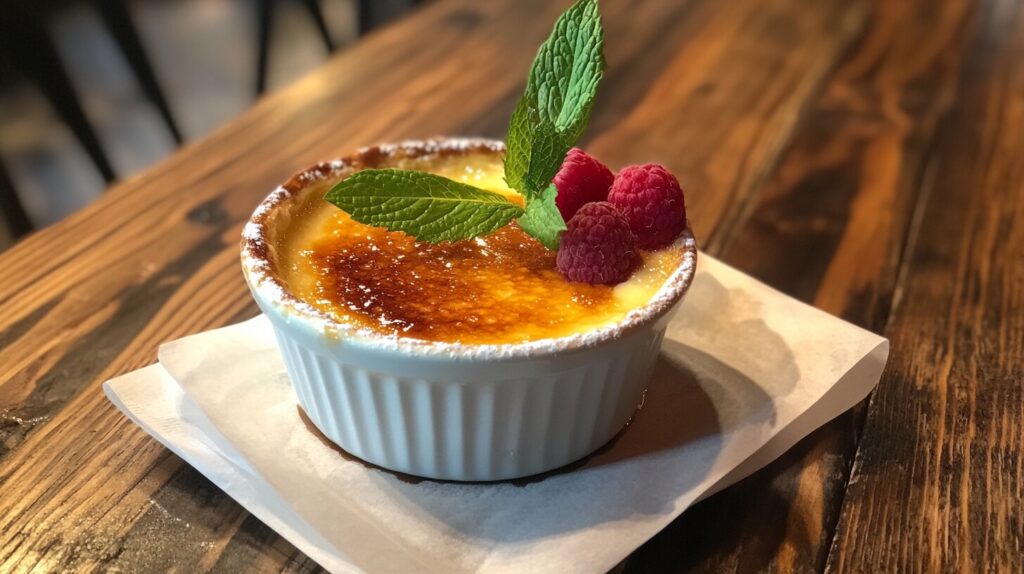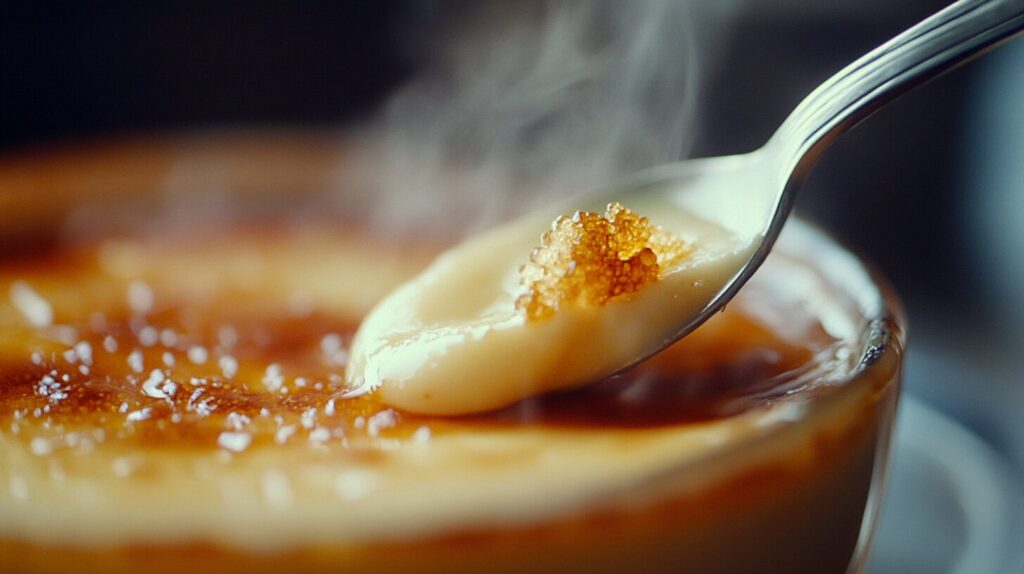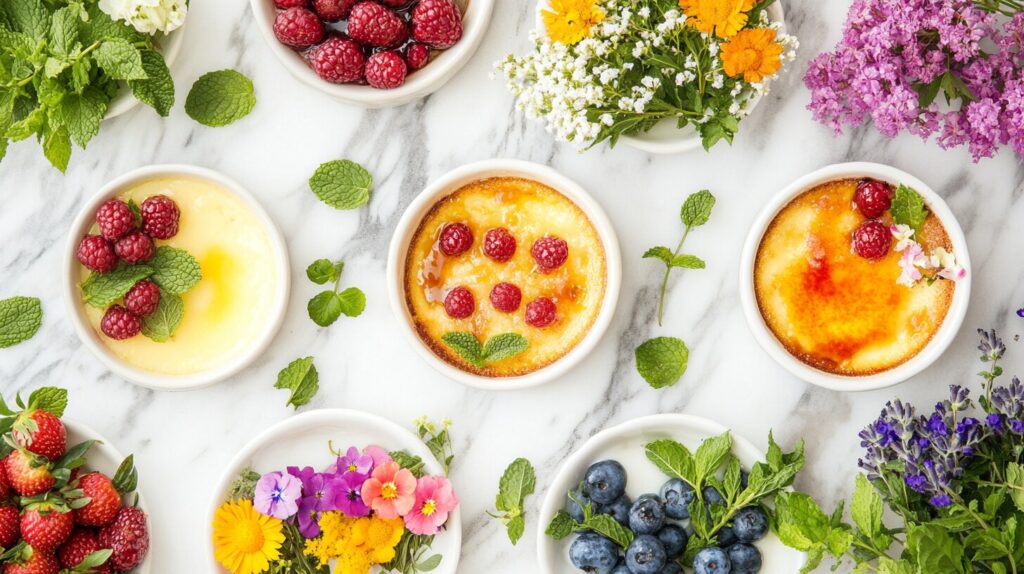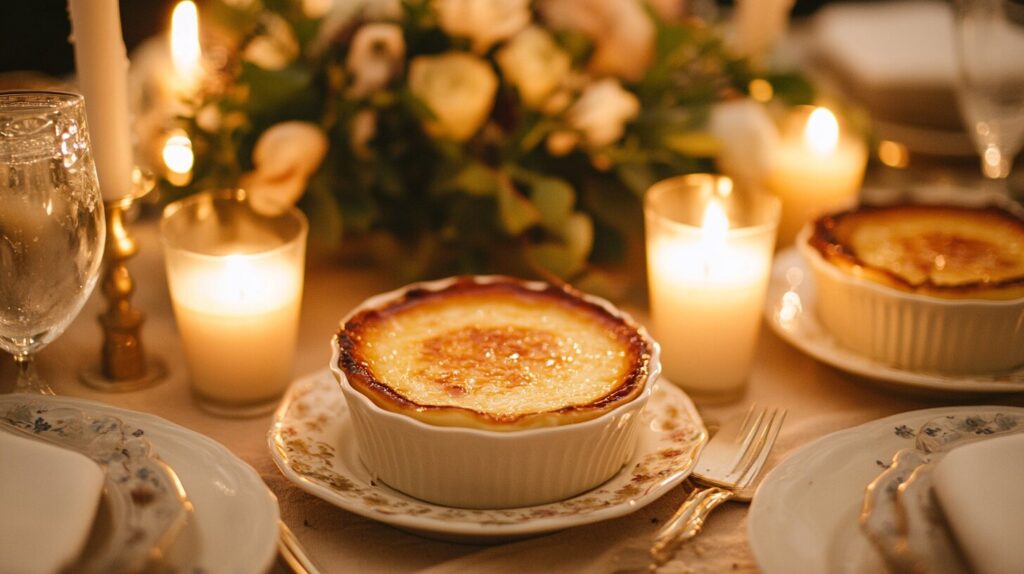
Few desserts evoke the elegance and sophistication of crème brûlée. That satisfying crack of the caramelized sugar, the creamy custard hidden beneath – it’s like a hidden treasure that delights the senses. But here’s the thing: to make it shine, you need to know how should crème brûlée be served to impress your guests. Wondering how should crème brûlée be served for the best experience? Let’s break it down into the art of serving this French classic, ensuring each bite leaves your guests in awe.
Table of Contents
Introduction to Crème Brûlée
Before we get into the nitty-gritty details, let’s take a moment to appreciate this iconic dessert. Crème brûlée translates to “burnt cream” in French, which makes perfect sense. This silky custard, topped with a brittle layer of caramelized sugar, is an experience in contrasts – creamy yet crisp, rich yet delicate.
The beauty of crème brûlée lies not only in its taste but also in the way it’s served. Presentation is everything! Whether you’re hosting a dinner party, making a romantic meal, or just treating yourself, serving crème brûlée the right way can elevate the entire dining experience.
The Perfect Temperature for Serving Crème Brûlée
Should Crème Brûlée Be Served Hot, Cold, or Room Temperature?
The temperature can make or break your crème brûlée. If you’re wondering how should crème brûlée be served in terms of temperature, the answer is simple: room temperature is the sweet spot.
Why not hot? The custard needs to set properly, and heating it up would ruin that smooth, creamy consistency. Too cold? The flavors get muted, and no one wants to break through an ice-cold sugar crust.
Room temperature allows the custard to be its creamy best while ensuring the caramelized sugar maintains its delicate crunch.
“The perfect crème brûlée is like a perfect handshake – not too cold, not too warm, but just right.” ✨
How Temperature Affects the Flavor and Texture
When crème brûlée is served at the right temperature, the custard melts smoothly on your tongue, offering its full flavor profile – rich vanilla, creamy goodness, and that sweet, slightly bitter caramel topping. At the wrong temperature, you lose that harmonious balance.
Here’s a quick guide to temperature and its effects:
- Too Hot: The custard might be runny, and the sugar could melt back into a sticky mess.
- Too Cold: The custard firms up, and the flavors don’t pop. Plus, the sugar crust might lose its crunch.
- Room Temperature: Custard stays creamy, sugar stays crisp. Perfection!
Choosing the Right Serving Dish
Traditional Ramekins: Why They’re the Gold Standard
There’s a reason why most crème brûlée recipes call for ramekins. These small, shallow, ceramic dishes are designed to deliver the perfect ratio of custard to caramelized sugar. They heat evenly, and their depth allows for just the right amount of creamy custard beneath that caramelized top.
Ramekins typically come in sizes ranging from 4 to 6 ounces, which is ideal for an individual serving. Plus, their classic look adds a touch of elegance to your dessert presentation.
Creative Alternatives to Ramekins
But hey, who says you have to stick to tradition? If you want to get creative, there are plenty of alternatives that can still work beautifully. Here are some ideas:
- Shallow Glass Bowls: They allow your guests to see the layers – very chic!
- Espresso Cups: Perfect for a smaller, daintier portion.
- Mini Cast-Iron Skillets: For a rustic twist.
- Mason Jar Lids: A quirky, hipster vibe that’s great for casual gatherings.
“The dish you choose is like a frame for your art – make sure it enhances the beauty of your crème brûlée!” 🎨
Just remember, the dish should be shallow enough to allow for that golden, caramelized crust without making the custard too thick.
Topping and Caramelization: The Signature Crunch

Achieving the Perfect Sugar Crust
Ah, the pièce de résistance of crème brûlée – that thin, glass-like layer of caramelized sugar. It’s all about creating a delicate balance between a golden-brown color and a satisfying crack. Here’s how to nail it:
- Use the Right Sugar: White granulated sugar works best because it caramelizes evenly. Avoid brown sugar; it tends to clump and burn.
- Even Layer: Sprinkle a thin, even layer of sugar over the custard. Too thick, and it won’t melt properly; too thin, and you’ll miss out on that crunch.
- Torch Technique: Hold a kitchen torch about 2 inches away from the sugar. Move it in circular motions until the sugar melts and bubbles, then turns a lovely amber color.
Tools for Caramelizing the Sugar Topping
Don’t have a kitchen torch? No worries! Here are some alternative methods for achieving that caramelized perfection:
- Broiler Method: Place your ramekins under a broiler for a minute or two, keeping a close eye on them. Be careful – sugar can go from caramelized to burnt in seconds!
- Spoon Method: Heat a metal spoon over a gas flame until red-hot, then carefully press it onto the sugar. It’s old-school, but it works!
Tip: Whichever method you choose, always caramelize the sugar just before serving to keep that signature crunch intact.
Garnishes: Enhancing the Presentation Without Overpowering the Dish

Best Garnishes for Crème Brûlée (Without Using Haram Ingredients)
Crème brûlée is stunning on its own, but a little garnish can take it to the next level. The key is to keep it simple and elegant. Here are some garnish ideas that are 100% halal-friendly:
- Fresh Berries: A few raspberries, blueberries, or a sliced strawberry add a pop of color and a hint of tartness.
- Mint Leaves: A small sprig of mint adds a fresh, vibrant touch.
- Edible Flowers: Think pansies, violets, or nasturtiums for a sophisticated flourish.
- Gold Leaf: For that extra touch of luxury – because why not?
How to Use Fruits and Edible Flowers for Decoration
When garnishing with fruits or flowers, less is more. You don’t want to hide the beautiful caramelized top. Instead, place a few berries or a single flower off-center to keep the focus on that glorious sugar crust.
“A good garnish is like a good accessory – it complements the main attraction without stealing the show.” 💎
H2: Common Serving Mistakes and How to Avoid Them
Serving crème brûlée might seem straightforward, but how should crème brûlée be served correctly? There are a few pitfalls that can easily derail your dessert masterpiece. Thankfully, these mistakes are easy to avoid once you know what to look out for.
Over-Chilling the Dessert
One of the most common errors is over-chilling the crème brûlée. While it needs to be cooled after baking, leaving it in the fridge for too long can harden the custard and dull the flavors. Ideally, crème brûlée should be chilled for 2 to 4 hours. If it stays in the fridge overnight, let it sit at room temperature for about 20-30 minutes before serving.
Why is this important? When crème brûlée is too cold, the custard loses its creamy, melt-in-your-mouth texture. The flavors of vanilla and cream are subdued, and the sugar topping can also lose its crunch when exposed to excessive moisture from the fridge.
Inconsistent Caramelization
Another misstep is inconsistent caramelization, which can lead to uneven texture or a burnt flavor. To avoid this, make sure you’re using the right amount of sugar and distributing it evenly across the custard’s surface. An uneven sugar layer will result in some areas burning while others remain pale.
Pro Tip: When using a kitchen torch, move it steadily in a circular motion, and don’t linger too long in one spot. Keep the flame about 2 inches away from the surface. The goal is to caramelize, not char.
🔥 “Consistency is key – you want every bite of crème brûlée to crack and melt perfectly!”
Choosing the Wrong Dish Size
Dish size matters more than you might think! Using dishes that are too deep can result in a custard-to-sugar ratio that’s off-balance. Ideally, your crème brûlée dish should be shallow and wide to ensure an even distribution of custard and caramelized sugar.
Stick to dishes that are about 1 inch deep and 4 inches in diameter. This allows you to enjoy that delicate crunch with each spoonful of smooth custard. Plus, a shallow dish helps the custard bake evenly, avoiding an undercooked center or an overcooked top.
Serving Crème Brûlée for Different Occasions

Crème brûlée is versatile enough to suit both elegant affairs and casual get-togethers. The way you serve it can add a personalized touch to your event. Here’s how to tailor your presentation for different occasions.
Elegant Plating Ideas for Formal Events
For a formal dinner or a fancy soirée, presentation is everything. Here’s how to elevate your crème brûlée for a sophisticated experience:
- Use Fine China or Crystal Ramekins: The right dish can make the dessert feel extra special.
- Gold Dust or Edible Gold Leaf: A sprinkle of gold dust adds a subtle shimmer. If you’re feeling extravagant, a tiny piece of edible gold leaf on top of the sugar crust screams luxury.
- Minimalist Garnishes: Think a single raspberry or a delicate mint leaf, perfectly placed. Keep it clean and elegant – less is more!
Casual Presentation for Home Gatherings
Hosting a more laid-back event? Crème brûlée can still shine without the formal fuss. Here are some fun, relaxed ways to serve it:
- Rustic Mason Jars: These jars add a charming, homespun vibe that’s perfect for family dinners or casual brunches.
- Personalized Ramekins: Use different colored ramekins to add personality. Everyone gets their own little dessert treasure.
- Playful Toppings: Add a dollop of whipped cream, a sprinkle of chocolate shavings, or a few fresh berries for a fun twist.
🍮 “Make your guests feel special, whether it’s a black-tie event or a backyard BBQ. The joy of crème brûlée is in its versatility!”
Pairing Crème Brûlée with Beverages and Desserts
Pairing crème brûlée with the right drink or dessert can elevate the entire dining experience. The creamy custard and caramelized sugar topping deserve a complement that enhances, not overwhelms, its delicate flavors.
Best Non-Alcoholic Drinks to Serve with Crème Brûlée
For a non-alcoholic pairing, focus on beverages that balance the richness of the custard. Here are some perfect options:
- Espresso or Coffee: The bitterness of coffee balances the sweetness of crème brûlée beautifully.
- Herbal Tea: A light chamomile or mint tea can cleanse the palate and offer a refreshing contrast.
- Sparkling Water with Citrus: Add a slice of lemon or orange for a zesty sparkle that refreshes between bites.
These drinks keep the focus on the dessert while offering a pleasant contrast of flavors.
Complementary Desserts to Create a Full Dessert Course
Want to create a full dessert spread? Pair crème brûlée with these complementary treats for an unforgettable finale:
- Fresh Fruit Platters: A mix of berries, melon, and grapes adds a refreshing contrast to the creamy richness.
- Madeleines: These delicate French cakes have a buttery, light texture that pairs beautifully with the custard.
- Chocolate-Covered Strawberries: The slight bitterness of dark chocolate balances the sweet, creamy custard.
When planning your dessert course, remember: balance is key! You don’t want anything too heavy or too sweet that competes with the crème brûlée.
Serving Crème Brûlée in Different Cultures and Traditions
Crème brûlée may be French, but variations of this iconic dessert can be found around the world. Understanding how other cultures approach serving similar desserts can inspire creative twists on your presentation.
Variations in Presentation Around the World
- Catalan Cream (Spain): Known as crema catalana, this dessert is often flavored with cinnamon and lemon zest. It’s traditionally served in a terracotta dish.
- Leche Flan (Philippines): A richer, denser version of crème brûlée, often served at room temperature and garnished with a caramel sauce.
- Burnt Basque Cheesecake (Spain): While not a custard, this dessert shares the burnt-sugar aesthetic and is served simply, with no toppings.
Exploring these variations can give you new ideas for serving crème brûlée while staying true to its elegant simplicity.
How to Respect Dietary Restrictions When Serving
When serving crème brûlée to a diverse group of guests, it’s essential to be mindful of dietary restrictions. Here’s how to make sure everyone can enjoy your dessert:
- Halal-Friendly Ingredients: Stick to high-quality dairy, eggs, and pure vanilla extract. Avoid any flavorings or toppings that contain alcohol or animal-based gelatin.
- Dairy-Free Option: Use coconut cream or almond milk to create a dairy-free version of the custard.
- Gluten-Free Assurance: Traditional crème brûlée is naturally gluten-free, but always double-check that no cross-contamination has occurred.
“A great host makes sure everyone can indulge in dessert without worry!” 🥰
Troubleshooting Common Crème Brûlée Problems
Even with the best techniques, sometimes things don’t go according to plan. If you’ve ever ended up with a soggy sugar topping, a runny custard, or a grainy texture, don’t worry! These are common issues, and they all have simple solutions. Let’s tackle these common crème brûlée problems head-on.
Why Is My Sugar Topping Soggy?
One of the biggest disappointments when serving crème brûlée is discovering a soggy sugar topping instead of that signature crisp crack. This usually happens because of excess moisture.
Causes and Solutions:
- Over-Chilling: If the custard is too cold, condensation can form on the surface, making the sugar wet. Solution: Let the custard sit at room temperature for 20-30 minutes before caramelizing the sugar.
- Humidity: High humidity in the environment can make the sugar absorb moisture. Solution: Caramelize the sugar just before serving to keep it crisp.
- Too Much Sugar: A thick layer of sugar can trap moisture underneath. Solution: Aim for a thin, even layer of sugar for the perfect crunch.
💡 “Remember, timing is everything! Caramelize that sugar right before serving to keep the magic alive.” ✨
How to Prevent the Custard from Being Too Runny
A runny custard is a clear sign that something went wrong during the baking process. The hallmark of a good crème brûlée is a smooth, set custard that’s creamy but not liquid.
Common Causes and Fixes:
- Undercooking: If the custard isn’t baked long enough, it won’t set properly. Solution: Bake the custard until it’s set around the edges but still slightly jiggly in the center (usually 40-45 minutes at 325°F or 160°C).
- High Oven Temperature: Baking at too high a temperature can cause the edges to overcook while the center remains runny. Solution: Use a moderate, steady temperature and bake in a water bath for even heat distribution.
- Incorrect Ratios: Too much cream or too little egg yolk can prevent the custard from setting. Solution: Follow a trusted recipe with the right balance of cream, egg yolks, and sugar.
Fixing Overly Thick or Grainy Custard
If your custard turns out too thick or has a grainy texture, you’re likely dealing with a problem during the custard-making process.
Causes and Solutions:
- Overcooking the Custard Mixture: When heating the cream and egg mixture, overcooking can cause the eggs to scramble. Solution: Heat the mixture gently and never let it boil. Aim for a temperature of about 160°F (70°C).
- Not Straining the Mixture: Small bits of cooked egg can result in a grainy texture. Solution: Always strain the custard mixture through a fine-mesh sieve before pouring it into the ramekins.
- Too Many Egg Yolks: While egg yolks are essential for setting the custard, too many can make the texture too dense. Solution: Stick to a ratio of about 4-6 yolks per 2 cups of cream.
🧑🍳 “Making crème brûlée is a delicate dance – gentle heat and careful attention will reward you with perfection!”
Final Tips for Serving the Perfect Crème Brûlée
You’re almost ready to serve the perfect crème brûlée! But how should crème brûlée be served to make sure everything goes smoothly? Here are some final tips to keep in mind:
- Use Quality Ingredients: The simplicity of crème brûlée means that each ingredient matters. Opt for high-quality cream, fresh egg yolks, and real vanilla beans or pure vanilla extract.
- Prep Ahead: You can make the custard a day or two in advance and store it in the fridge. Just caramelize the sugar right before serving.
- Don’t Rush: Take your time when caramelizing the sugar and plating the dessert. The little details make a big difference.
- Practice the Crack Test: A perfect crème brûlée should pass the “crack test” – when you tap the sugar with a spoon, it should shatter with a satisfying sound.
- Keep It Simple: Sometimes, less is more. A well-executed classic crème brûlée doesn’t need fancy embellishments to impress.
🌟 “Crème brûlée isn’t just a dessert; it’s a moment of joy. Take your time, enjoy the process, and savor every bite!”
Conclusion: Making Every Crème Brûlée Experience Memorable
Crème brûlée is more than just a dessert – it’s a delightful experience that combines taste, texture, and presentation. Now that you know how should crème brûlée be served, you can create an unforgettable dining experience. Serving it perfectly means paying attention to temperature, mastering the sugar crust, choosing the right dish, and adding thoughtful garnishes.
By avoiding common mistakes and embracing simple, elegant presentation ideas, you can ensure that every crème brûlée you serve is a showstopper. Whether you’re hosting an elegant dinner party or enjoying a cozy night in, this classic dessert is sure to leave a lasting impression.
So go ahead, grab your ramekins, your torch, and some fresh cream. Your guests are in for a treat – and so are you! 🍮
FAQs
How long can crème brûlée be stored before serving?
You can store crème brûlée for up to 2-3 days in the fridge before serving. Just remember to caramelize the sugar topping right before serving to keep it crisp.
Can I make crème brûlée without a kitchen torch?
Yes! You can caramelize the sugar topping under a broiler. Just place the ramekins under the broiler for about 1-2 minutes, keeping a close eye to avoid burning the sugar.
What’s the best sugar to use for the topping?
White granulated sugar works best because it caramelizes evenly. Avoid using brown sugar, as it tends to clump and burn unevenly.
Can I make a dairy-free crème brûlée?
Absolutely! You can use coconut cream or almond milk as a substitute for heavy cream. The texture will be slightly different, but it will still be delicious.
How do I know when the custard is fully baked?
The custard is ready when it’s set around the edges but still jiggly in the center. It should look firm but not liquid. This typically takes 40-45 minutes at 325°F (160°C).
Why is my crème brûlée grainy?
A grainy texture usually happens if the custard mixture is overcooked or not strained. Heat the mixture gently and always strain it before baking for a silky-smooth texture.
Discover More Decadent Dessert Delights 🍰
If you loved learning how to serve crème brûlée to perfection, why not explore more delicious and creative dessert recipes? Try our Crab Brûlée Recipe for a surprising twist on a classic or indulge in the warm, comforting flavors of Cinnamon Sugar Muffins – they’re a perfect treat for any time of day! Curious about healthier snacking options? Check out our guide on Rice Cakes Benefits and Recipes for Healthy Snacking.
These delightful resources will keep your dessert game strong and your taste buds happy! ✨
